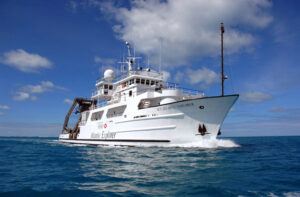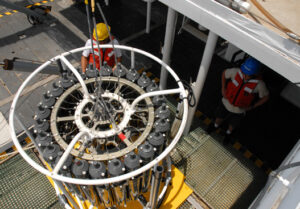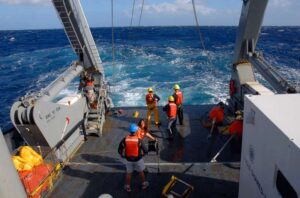By the Numbers: A Look at BIOS’s R/V Atlantic Explorer

Ten years ago this fall, BIOS purchased a 168-foot submersible support ship from Harbor Branch Oceanographic Institute in Florida, reconfigured lab and deck space, modified it for science work offshore Bermuda, and 18 months later sailed the converted oceanographic research vessel into its new homeport in St. George’s, Bermuda. Since then, that vessel—renamed research vessel (R/V) Atlantic Explorer—has sailed tens of thousands of miles on behalf of BIOS scientists and hundreds of other researchers worldwide for science work and marine education initiatives.
Marine Operations Coordinator Susan Brittner, who joined the marine operations staff in 2009, reviewed some of the vessel’s recent milestones, and previewed what’s ahead as the ship enters its busiest sailing and science season of the year.

Nautical miles traveled in 2014: 18,200 (or 21,174 miles. That’s a few thousand miles shy of the distance around the globe at the equator)
Sea days planned for 2015: 157 (with only 17 days at dock from the beginning of August until the end of the year. The schedule includes a month-long U.S. Navy cruise, as well as the ship’s usual, twice-monthly visits to the Bermuda-Atlantic Time-series Study site and Hydrostation “S” site)
142 scientists and researchers used the vessel for their work last year. They came from 41 different universities and research organizations
Number of BATS and Hydrostation “S” cruises in 2014: 17
Crew size: 12
Scientific party size maximum: 22

Number of nations represented by participants in 2014: 15 (most hailed from the United States, United Kingdom, and Bermuda. Other nations included Canada, China, and Australia).
Number of different sensors or pieces of equipment on the ship collecting scientific information: 33
Longest voyage to date: 28 days, covering 6,900 nautical miles. In August 2012, the R/V Atlantic Explorer sailed from Bermuda to Portland, Maine (to clear customs and obtain provisions) then up to Boothbay, Maine (to mobilize personnel) before heading to the Labrador Sea to conduct science and finally back to Bermuda.
